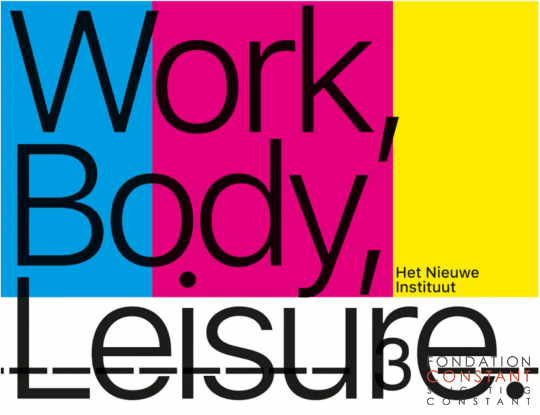Image


3001
Het Nieuwe Instituut is the commissioner of the Dutch Pavilion at the Biennale Architettura 2018, entitled WORK, BODY, LEISURE, the official Dutch contribution to the event. From 21 December, WORK, BODY, LEISURE will be exhibited at Het Nieuwe Instituut in Rotterdam.
WORK, BODY, LEISURE, first conceived as the Dutch contribution to the 16th International Architecture Exhibition of La Biennale di Venezia, addresses the spatial configurations, modes of living, and notions of the human body engendered by disruptive changes in labor ethos and conditions. Over the last year, a diverse group of contributors have gathered to develop a transnational research program and an ongoing exchange. This collaborative endeavor seeks to foster new forms of creativity and responsibility within the architectural field in response to emerging technologies of automation. A domain of research and innovation that, despite its ongoing transformation of the built environment and bodies that inhabit it, is still largely devoid of a critical spatial perspective.
The 2018 Dutch Pavilion envisioned as a collaborative research endeavor by a national and international network. This network, which brings together the expertise of architects, designers, knowledge institutions and the private sector, tests and disseminates outcomes before, during, and beyond the exhibition timeframe and venue of the Biennale Architettura 2018. The curator, Rotterdam-based architect and researcher Marina Otero Verzier, Director of Research at Het Nieuwe Instituut, acting as the instigator and creative mediator of the multiple contributions.
Details of selected commissioned exhibitors and projects for the extende program of the Dutch Pavilion can be found in the Jury Report, and an overview of all those involved in the programme on the Team page of this web magazine. In addition the teams of the Belgian, Dutch and Spanish pavilions launched a joint Open Call entitled Outside the Box for a spatial intervention and action in the outdoor space in front of the three adjoining pavilions, and during the official opening day of the event. With the title WORK, BODY, LEISURE, the 2018 Dutch Pavilion addressed the spatial configurations, living conditions, and notions of the human body engendered by disruptive changes in labor ethos and conditions. The project seeks to foster new forms of creativity and responsibility within the architectural field in response to emerging technologies of automation.
The Netherlands is, arguably, a testing ground where the future of labor has been and continues to be reimagined. The work of architect and artist Constant Nieuwenhuys has been a particular trigger for this conversation. In Constant’s New Babylon (1956–74)—an architectural paradigm of free space and leisure afforded by automation—society devotes its energy to creativity and play, and individuals can design their own environments. And yet, as Constant’s oeuvre evolved, his optimistic vision on the possibilities and pleasures of automated labor gradually gave way to a more conflicted perspective. Violence would not be eradicated by the new technological order, mobilized to satisfy society’s immediate needs; it would become, rather, an intrinsic part of its processes and aims.
“Automation is a material condition and achievable,” Constant claimed in May 1980 in a lecture at the Faculty of Architecture of TU Delft. More than thirty years later, the architecture of full automation is currently being implemented in the city of Rotterdam, from the self-managed logistical infrastructures of the port to the logic and relations that define the physical and social landscape of the city, and across agricultural clusters in the Netherlands. Reflecting on a spectrum of theoretical viewpoints—including New Babylon’s initial proposal for a leisure-oriented society liberated from the bondage of labor; the recent techno-optimistic premise that full automation will bring increasing bounty and luxury; and the dystopian forecast of rampant, machine-abetted human unemployment and inequality—WORK, BODY, LEISURE claims that these visions are already shaping contemporary labor structures and, ultimately, our capacity to redesign them according to a different set of ethical principles.
The project builds upon Automated Landscapes, a long-term collaborative research initiative on the implications of automation for the built environment, launched by Het Nieuwe Instituut in 2017 and directed by its Research Department. In the Dutch Pavilion, this perspective will be in dialogue with contributions by other individuals and organizations. In addition to historical and present-day case studies of automated landscapes in the Netherlands, the project will analyze spatial arrangements and protocols that are molded for the interaction between humans and machines; will explore spaces that challenge traditional distinctions between work and leisure; will address the ways in which evolving notions of labor have categorized and defined bodies at particular moments in time; and will discuss the legal, cultural, and technical infrastructures that enable their exploitation.
| Title | Year |
|---|---|
| WORK, BODY, LEISURE | 2018 |
| The Hyper-Architecture of Desire | 1998 |
No related items available
No related items available
No related items available
No related items available
| Title | Year |
|---|---|
| Erotic Space | 1971 |
No related items available
No related items available